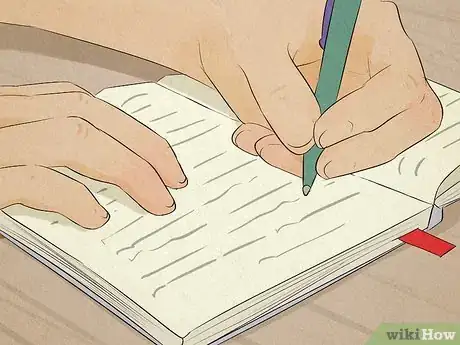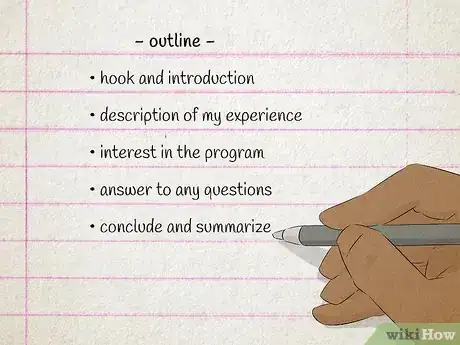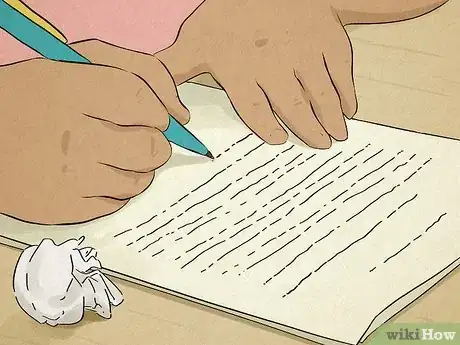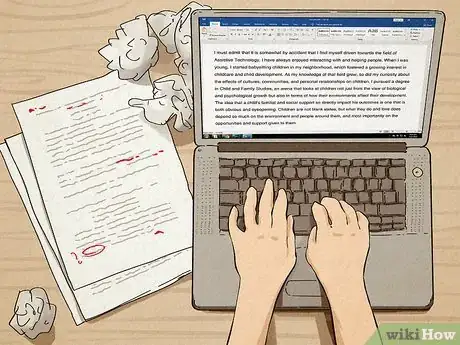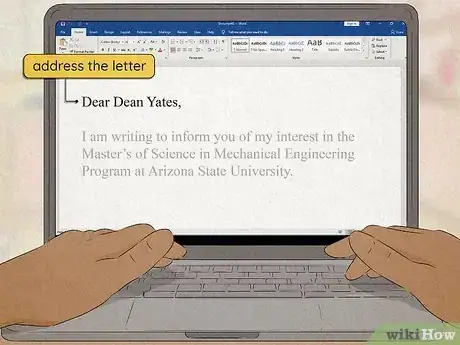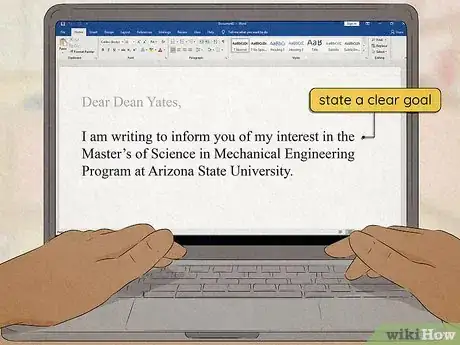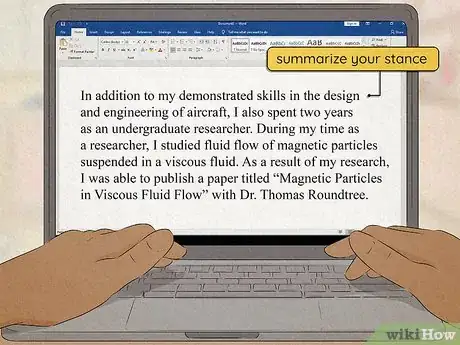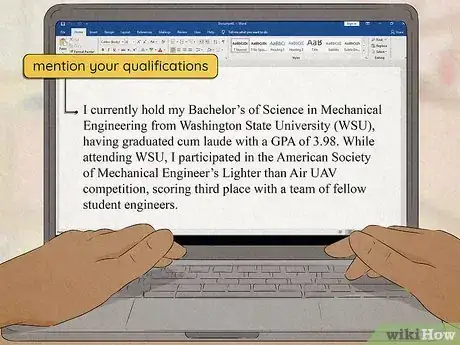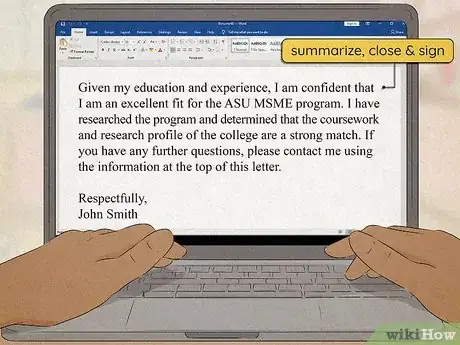wikiHow is a “wiki,” similar to Wikipedia, which means that many of our articles are co-written by multiple authors. To create this article, 10 people, some anonymous, worked to edit and improve it over time.
This article has been viewed 67,635 times.
Learn more...
A motivation letter is a type of cover letter typically sent to international universities—particularly those within various European countries—when you wish to apply to a competitive graduate school program or scholarship program. Effective motivation letters describe essential information about prospective students in a creative, passionate manner. Since this part of the application process can be so crucial, you should draft and edit the letter thoroughly before sending it.
Steps
Brainstorming
-
1Take notes. During the entire brainstorming portion of the process, take detailed notes that you can refer back to while writing the letter. Include both primary information and secondary details, regardless of whether or not you think you'll actually use them for the letter itself.
-
2Research the university and its program. Read through any print or digital literature provided to you by the university, including its website. Pay close attention the school's admission requirements for the program you're pursuing.[1]
- The university will usually describe the qualifications they hope to see from prospective students, and you can use that information to tailor your motivation letter toward that specific school.
- For instance, if the university is heavily involved in humanitarian efforts related to the program topic, you could give more attention to your own humanitarian interests. On the other hand, if the school literature strictly focuses on academics, you'll know to keep the letter equally focused on academic aspirations and experiences.
Advertisement -
3Ask yourself why you should be chosen. The program admissions board will want to know why you should be chosen over someone else, but before you can give the board that information, you'll need to have the question settled for yourself.
- Review your academic career through now. Figure out what courses, instructors, and influences led you to the path you're presently pursuing and determine how it happened.
- Think about why you chose this school and this program. Consider all of your motivations, including the personal and professional ones.
Following the Writing Process
-
1Write an outline. Gather your notes together and try organizing them into an outline. Your outline should include separate sections for the introductory statement, each separate body paragraph, and your closing remarks.
- If you're not comfortable making an outline, consider arranging your notes into a flow chart or similar organizational tool. The important part of this step is to provide structure to your previously unstructured ideas.
-
2Draft the letter. As soon as you've organized your thoughts, you should begin writing the first draft of your letter. Understand that this should only be a first draft; you'll need to make revisions before it's ready to send.
- Include everything you can think of that seems important, and describe it with as much sensory detail as possible. You might end up with way too much information and way too many pages, but you can trim away the unnecessary points during the editing portion of the process.
- Refer to both your informal notes and formal outline for this part of the process. Also, note that you should follow the guidelines provided in the “Structuring Your Letter” section of this article.
-
3Return to the letter several days later. After completing your first draft, step away from the letter for at least one or two days before you think of editing it.
- At a very basic level, you need to proofread the grammar and structure of the letter.
- Even more importantly, you also need to proofread the letter for accuracy and consistency. Your facts should be correct, your ideas should be original, and your tone should be evenly professional.
-
4Ask for constructive criticism from reliable sources. While not strictly necessary, it may help to get external opinions from qualified sources. The best people to ask include professors and students currently enrolled in graduate school.
- Ideally, you should try getting in touch with someone already enrolled in the specific program you're applying to. That individual will have a clearer understanding of what the university wants from its students.
-
5Revise the letter as needed. Analyze the motivation letter using your own critiques and the critiques of others. Don't be afraid to rewrite the letter several times until you get it right.
- Remove redundant language or ideas, as well as information that isn't directly focused on the main idea of the letter. On average, the letter should only be about one full page in length; anything longer is usually considered unnecessary and discouraged.
- Note that some programs may look for letters ranging between two to three pages long. It's best to read through the application for specific information regarding length; if you are unable to find such information, sticking with one page should be safe.
- Make sure that the most important arguments are positioned earlier in the letter than less significant points, and rearrange the contents of the letter as needed to make it flow well.
Structuring the Letter
-
1Address the letter as specifically as possible. If you know the name of the individual who reviews admissions applications, it's best to address the letter to that individual by name.[2]
- If you are unable to track down a specific name, you should at least try to address the reader by position. Options might include:
- “Dear Admissions Counselor,”
- “Dear Admissions Board,”
- “Dear Admissions Director,”
- Only use generic forms of address (e.g., “To Whom It May Concern,” “Dear Sir or Madam”) as a last resort.
- If you are unable to track down a specific name, you should at least try to address the reader by position. Options might include:
-
2State a clear goal. The first paragraph of your motivation letter should concisely summarize the rest of the letter, giving the reader an accurate idea of what to expect.
- This first paragraph should only consist of one to three sentences, and you should indirectly state that you are presenting a motivation letter for your chosen program.
- For example, your opening line could be as simple as: "I am writing this letter to express my interest in the ABC Program of XYZ University."
-
3Summarize your stance. For the body of the letter, you need to tell the application board why you think this specific university and its program are your best option. You also need to explain why the program should accept you over other potential candidates.
- Refer to the note you took previously regarding your own motivations and qualifications.
- Explain why the school should choose you. Describe your past academic and professional experiences as they apply to the program you're interested in. You need to provide facts here, but you also need to show how those facts affected you as a person.
- For example, you might mention how you reacted to the topic courses at an earlier academic level, like undergraduate school. Instead of merely stating that you took courses in the topic, describe how the content of those courses left you feeling fascinated, determined, or curious.
- Explain why you chose this school, program, and location. Most universities are interested in accepting students who have a strong passion or motivation for attending.[3]
- Note your professional goals and why you think this program offers you the best chance of achieving them. You can refer to the program's common selling points as long as you don't quote them directly.
- Indicate what appeals to you about the university itself. If you'll be an international student, you should also describe why you're interested in studying within the applicable country in particular. For example, if the school is located in Germany, explain why you wish to pursue graduate studies in Germany.
-
4Draw attention to your primary qualifications. While demonstrating why you're a good fit for the program, you'll need to cite academic experiences, personal qualities, and other related experiences. Focus on the points most directly related to the program itself.
- Consult your CV, but don't copy it. Typically, you'll need to include a copy of your Curriculum Vitae (CV) in the application paperwork that accompanies your motivation letter. You can use information from your CV to trigger your memory while writing, but the letter should not be an exact duplication of the CV itself. If necessary, refer the reader of your letter to the CV to provide any supporting detail you cannot concisely list within the letter itself.
- Support your claims. Each time you mention one of your strengths, you need to qualify it with adequate supporting detail. It isn't enough to say that you're a hard worker; you need to provide examples of experiences demonstrating that idea.
- Don't brag about yourself. You shouldn't go out of your way to seem humble, but you also need to avoid language that seems arrogant or overly confident. Do this by adhering mostly to concrete fact and leaving subjective analysis out of the equation.
-
5Restate your position. For the concluding paragraph of your letter, briefly restate your desire to enter the program. Offer a polite expression of gratitude for the admission board's time and consideration before closing and signing the letter.
- Your concluding paragraph should be around three sentences long. Rephrase your introductory line and summarize the main points of each body paragraph in one sentence each.
- Finish by thanking the readers for their time and consideration, and sign off with a professional closing (e.g., "Respectfully yours,") and your full name.
Making Your Letter Outstanding
-
1Use clean, concise language. Remain focused on the point of the letter, using grammatically correct language that describes your intent and qualifications in direct terms. Maintain an active voice and stay away from flowery or muddy descriptions.
- Avoid cliché phrases or terminology. Phrases that are frequently relied upon actually reflect poorly on you since using them implies a lack of creative thought. When you feel tempted to use a particular cliché, dissect the idea into its "why" and "how" aspects, demonstrating the truth of that idea through active examples instead of flat statements.
- Examples of common clichés
- "I am highly motivated to..."
- "I have always loved..."
- "My greatest goals are..."
- Don't plagiarize content. Even though you used information from the program literature to help you form your ideas, you should not repeat that information word for word. If the program highlights its "state-of-the-art equipment," stay away from the phrase "state-of-the-art equipment."
- Don't copy form. You might find it helpful to look at sample motivation letters for additional insight into the structure and tone you'll need to apply, but you should avoid copying the form too closely. After all, anyone can copy a form letter and fill in the blanks; you need to show that you're just "anyone," and using an original tone can do just that.
- Avoid cliché phrases or terminology. Phrases that are frequently relied upon actually reflect poorly on you since using them implies a lack of creative thought. When you feel tempted to use a particular cliché, dissect the idea into its "why" and "how" aspects, demonstrating the truth of that idea through active examples instead of flat statements.
-
2Keep a positive tone. Your letter should focus on positives rather than negatives. If you choose to describe hardships or challenges faced in the past, emphasize how you overcame those difficulties instead of stressing the severity of the problems themselves.
- Stay away from your weak points. You'll probably be asked about your weaknesses during an interview, but the motivation letter needs to sell your strengths.[4]
- Focus on the future. While you do need to describe your past qualifications, you also need to demonstrate that you're looking ahead at what's to come. For instance, instead of describing your lack of experience within a certain field explored in the broader program, state that you are eager to learn about that field and feel eagerness toward the novelty of it.
-
3Balance both professional tone and personal information. While you need to personalize the letter to show your experiences and your interests, it is definitely a professional letter and should be formatted and phrased as such.
- Keep the attention on intellectual motivations. While you may have religious, altruistic, or other personal motivations related to your “heart,” admissions personnel are more interested in motivations related to the “mind.” Emphasize your academic and professional goals.
- At the same time, you should stand apart from the crowd as much as possible. Don't generalize your professional goals too much; be as specific to yourself as you can be without diving into your emotional or private motivations.
-
4Remain honest. No matter what you write, you need to be honest about it. Avoid exaggerating past experiences or other qualifications beyond their actual scope.
- On an ethical level, the position you're aiming for should be filled by the most qualified candidates. You need to believe in your own level of ability to survive in something this competitive, and lying about your qualifications can be an indication that you aren't confident about the truth of who you are.
Community Q&A
-
QuestionHow do I write a motivation letter for two different programs in the same department of a university? Should I write a single motivation letter for both of them or a separate one for each?
 Community AnswerIt is always better to write a unique letter for each program you wish to attend, no matter how similar they are. Even if both letters arrive at the same person's desk, they will be happy to see your motivation and effort to write a tailored letter for each.
Community AnswerIt is always better to write a unique letter for each program you wish to attend, no matter how similar they are. Even if both letters arrive at the same person's desk, they will be happy to see your motivation and effort to write a tailored letter for each. -
QuestionWhat is a good format for a motivation letter?
 Community AnswerThe best is to use the PDF format.
Community AnswerThe best is to use the PDF format.
References
- ↑ https://www.mastersportal.com/articles/406/write-a-successful-motivation-letter-for-your-masters.html?attempt=1
- ↑ http://www.hse.ru/data/2014/03/18/1332548147/motivationletter_checklist.pdf
- ↑ http://ic.daad.de/imperia/md/content/islamabad/letter_of_motivation.pdf
- ↑ http://www.stepstone.lu/Career-Advice/application-letter/10-tips-for-writing-a-persuasive-letter-of-motivation.cfm
About This Article
To write a motivation letter, start by researching the university’s program, including their mission statement and requirements. Then, outline an intro that provides a summary and a clear goal, like, "I am writing this letter to..." In the body, list your qualifications and explain why they make you an ideal candidate. Conclude with another summary. After outlining, write the first draft, using concise, professional language. Wait a few days and then revise. To learn more about writing a motivational letter, like who to address it to, keep reading!
